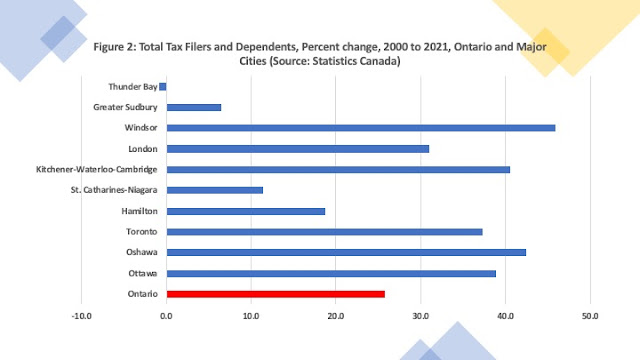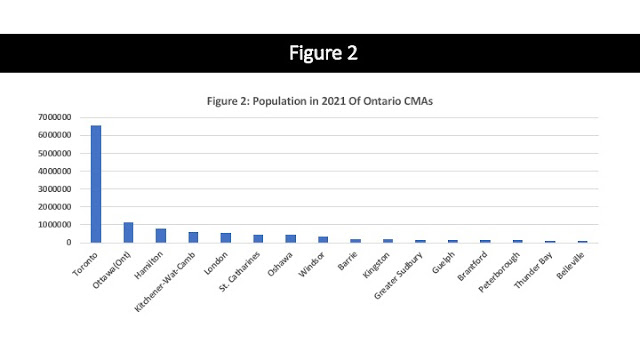The news that the Greater
Sudbury CMA is poised to reach 200,000 people much sooner rather than later
highlights how Canada’s recent population surge has begun to permeate even regions
and cities that for years have seen rather lack luster population and economic
growth. In the case of Sudbury, the city’s Mayor has made it his
goal to grow the city-region’s population to 200,000 by 2050 and given
that it is 2025 and population seems to be over
190,000, it is apparent the Mayor may still be in office by the time the
goal is reached and thus able to personally celebrat the achievement.
Meanwhile, Thunder Bay has embarked on a “Smart
Growth” Plan that among other things also seeks to attract new residents
and population though it has not set a goal for population. Such goals and forecasts are dangerous given that the urban renewal schemes of the 1960s forecast that Thunder Bay (The Lakehead) was going to hit 186,000 people by the 1980s. Yet, even in
Thunder Bay, the news is that population growth has been
higher than anticipated in recent years with international migration
boosting the population of the CMA to over 130,000.
All the optimism for growth in Northern Ontario’s two major
urban areas is a cause for celebration given what have been decades of low
expectations and performance. At the same time, one
needs to place the recent performance of northern Ontario’s premiere cities
into comparative context. When one looks
at the growth of population of Greater Sudbury, and Thunder Bay relative to other
Canadian CMAs, the results suggest that even when growth picks up, the lag abides.

Population data for Canada’s CMAs from Statistics Canada is
used to plot several charts to provide some context for the last
statement. Figure 1 plots Canada’s
population by ranked CMA in 2001 but by the current number of CMAs which have
increased since that year (for example, Red Deer, Drummondville, Nanaimo, Kamloops
and Chilliwack were not CMAs in 2001 but have since grown to over 100,000
people). Not surprisingly, Toronto, Montreal and Vancouver were the top three
CMAs at 4.9, 3.6 and 2.1 million people respectively. Of the forty CMAs shown
in Figure 1, Greater Sudbury ranked 21st out of 40 with 164,210
people while Thunder Bay ranked 31st. Below Thunder Bay were Moncton, Peterborough,
Bellville, Kamloops, Lethbridge, Nanaimo, Drummondville, Chilliwack and Red
Deer.

Fast forward to 2024 and Figure 2. In 2024, Toronto,
Montreal and Vancouver were still the three largest CMAs at 7.1, 4.6 and 3.1
million people respectively. Greater
Sudbury, even with nearly 192,000 people, had fallen to 25th place
while Thunder Bay with 133,000 had fallen to 34th place out of 40. Figure 3 plots the percent growth in
population from 2001 to 2024 for these 40 CMAs and here the evidence shows that
population growth was the highest in Calgary, Edmonton, Kelowna, Red Deer and Chilliwack
with growth ranging from a high of 82 percent for Calgary to a low of 59
percent for Chilliwack. In terms of growth rates, Greater Sudbury grew 17
percent putting it in 37th place in terms of population growth while
Thunder Bay at 5 percent growth came 39th out of 40th. While second last place in the population growth
sweepstakes is better than last – the honour which went to Saguenay – it was
not a sterling performance.

On the plus side all CMAs saw growth from 2001 to 2024 but
in the end it is both growth per se as well as relative growth that matters if
you are seeking to promote a growth agenda.
Of course, the key question is why Thunder Bay (and even Sudbury) have
continued to do so poorly when it comes to the relative population growth
sweepstakes. Bear in mind that
population growth per se is only one indicator of economic performance and the presence
of economic opportunity. Rising per capita
incomes and by extension individual economic welfare require the economy to
grow faster than population. Thunder Bay
and Greater Sudbury have done somewhat better in terms of per capita income growth. For example, out of 64
major Ontario communities ranked by CMHC, Thunder Bay and Sudbury rank 41st
and 21st respectively in terms of average household
income before taxes placing them closer to the middle of the distribution.
Still, despite the celebration of recent population and
urban growth, it remains that Greater Sudbury and Thunder Bay are at the bottom
in terms of their population growth when it comes to wider comparisons with the
rest of Canada. And even worse, Sudbury’s population growth rate since 2001 has
been three times that of Thunder Bay at 17 versus 5 percent. Thunder Bay
appears to have been particularly afflicted by low overall growth both in terms
of its economy and its population and the question is why? Is it a function of remoteness? Likely not as many of these CMAs have as many
locational disadvantages as Thunder Bay which likes to boast it is in the
middle of the country at the confluence of major transport links. Is it the
absence of resources or skilled labour? Again,
likely not given its location in the mineral and forest rich shield and the
presence of both a community college and university in the community.
This leads to another factor – institutions, or the arrangements that people have for dealing with one another. What is it about Thunder Bay in terms of the
environment of the community both in terms of local culture and governance that
may be militating against growth? I would
argue that it is the absence of competitive behaviour and the prevalence of monopoly
that has most stifled the city’s economic growth and development. In this regard, Thunder Bay is a microcosm of
what ails Canada as a whole – a country that has long tolerated monopolies and
oligopolies in its economic fabric as manifested in its banking, telecommunication,
transport and retail sectors.
In Thunder Bay, this type of non-competitive behaviour that often
seeks to block entry of new firms through lengthy approval processes has been compounded by a monopoly municipal government
in the wake of amalgamation that has also effectivelt stifled local initiative and innovation
(it is no coincidence economic growth in the city dramatically slowed after the
merger of the ultra competititve cities of Port Arthur and Fort William in 1970) and a growing reliance on the
public sector as the main driver of activity.
If one looks at Thunder Bay, one third of the population essentially
works for the public sector and one third is retired or not working and deriving the bulk of
its income from some sort of public sector pension. The remaining third is your private sector
and even they are essentially tailoring their businesses to attracting the
spending of either the public sector directly via public sector construction
projects and contracts or those who derive their incomes from public sector
pensions. With the taxpayer footing the bill in one form or another, there is little incentive for competitive behaviour even in the local private sector and their captive market often results in cost overruns especially on public sector projects.
Needless to say, it is amazing
that Thunder Bay's population has grown as much as it has.



























